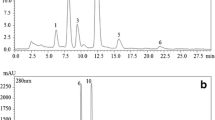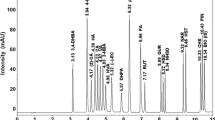Abstract
The aim of this research was to develop a method for simultaneous quantification of proteins and main polyphenolic compounds extracted from oleaginous meal by aqueous media. Size exclusion chromatography with a Biosep column (exclusion range from 1 to 300 kDa) and acetonitrile/water/formic acid (10:89.9:0.1 v/v) eluent at 0.6 mL min−1 yielded the most efficient separation of sunflower proteins and chlorogenic acid monoisomers (3-caffeoylquinic acid, 5-caffeoylquinic acid, and 4-caffeoylquinic acid). After a study of the stability of the extract components, the incorporation of a stabilization buffer (0.5 mol L−1 tris(hydroxymethyl)aminomethane-hydrochloric acid/1.0 mol L−1 sodium chloride at pH 7) was proposed to avoid polyphenol-protein interactions and/or isomeric transformation. The use of 214 nm as the wavelength for protein quantification was also included to minimize the effect of interference from polyphenol-protein interactions on the quantification. Under the used experimental conditions, the protein and chlorogenic acid monoisomer signals remained stable during 300 min at 20 °C (95–125% of the starting value). The developed method was validated and parameters such as specificity, sensitivity, precision, and accuracy were determined. The results from size exclusion chromatography correlated well with the results of protein determination by the reference Kjeldahl method. The proposed method was successfully applied for rapeseed extract analysis making simultaneous quantification of proteins and major rapeseed polyphenols (sinapine and sinapic acid) possible.

Graphical abstract






Similar content being viewed by others
References
Gonzalez-Perez S. Sunflower proteins: overview of their physicochemical, structural and functional properties. J Sci Food Agric. 2007;87:2173–91.
Wildermuth S. Chlorogenic acid oxidation and its reaction with sunflower proteins to form green-colored complexes. Compr Rev Food Sci Food Saf. 2016;15:829–43.
Pickardt C. Optimisation of mild-acidic protein extraction from defatted sunflower (Helianthus annuus L.) meal. Food Hydrocoll. 2009;23:1966–73.
Bongartz V. Evidence for the formation of benzacridine derivatives in alkaline-treated sunflower meal and model solutions. Molecules. 2016;21:91.
Ivanova P. Functional properties of proteins isolated from industrially produced sunflower meal. Int J Food Sci. 2014;3:203–12.
Pickardt C. Pilot plant preparation of light-coloured protein isolates from de-oiled sunflower (Helianthus annuus L.) press cake by mild-acidic protein extraction and polyphenol adsorption. Food Hydrocoll. 2015;44:208–19.
Gueguen J. Plant proteins: context and potentialities for human food. Cahiers de nutrition et de dietetique. 2016;51:177–85.
Aider M. Canola proteins: composition, extraction, functional properties, bioactivity, applications as a food ingredient and allergenicity - a practical and critical review. Trends Food Sci Technol. 2011;22:21–39.
Tan SH. Canola proteins for human consumption: extraction, profile, and functional properties. J Food Sci. 2011;76:16–28.
Gonzalez-Perez S. Isolation and characterization of undenatured chlorogenic acid free sunflower (Helianthus annuus) proteins. J Agric Food Chem. 2002;50:1713–9.
Ozdal T. A review on protein-phenolic interactions and associated changes. Food Res Int. 2013;51:954–70.
Sapan CV. Colorimetric protein assay techniques. Anal Biochem. 1999;29:99–108.
Reichelt WN. Bioprocess monitoring: minimizing sample matrix effects for total protein quantification with bicinchoninic acid assay. Anal Biochem. 2016;43:1271–80.
Winters AL. Modification of the Lowry assay to measure proteins and phenols in covalently bound complexes. Anal Biochem. 2005;346:43–8.
Weisz GM. Identification and quantification of phenolic compounds from sunflower kernels and shells by HPLC-DAD/ESI-MSn. LWT Food Chem. 2009;115:758–65.
Pedrosa M. Determination of caffeic and chlorogenic acids and their derivatives in different sunflower seed. J Sci Food Agric. 2000;80:459–64.
Li J. Identification and quantification of phenolic compounds in rapeseed originated lecithin and antioxidant activity evaluation. LWT Food Sci Technol. 2016;73:397–405.
ICH I. Q2 (R1): Validation of analytical procedures: text and methodology. In: International Conference on Harmonization, Geneva. 2005.
Clifford MN. Chlorogenic acids and other cinnamates - nature, occurrence, dietary burden, absorption and metabolism. J Sci Food Agric. 2000;80:1033–43.
AOCS International. Official Method 991.20. Nitrogen (total) in milk. Official methods of analysis, 19th edn. Gaithersburg: AOCS International; 1995.
Laemmli UK. Cleavage of structural proteins during the assembly of the head of bacteriophage T4. Nature. 1970;227:680–5.
Friedman M. Effect of pH on the stability of plant phenolic compounds. J Agric Food Chem. 2000;48:2101–10.
Xue M. Stability and degradation of caffeoylquinic acids under different storage conditions studied by high-performance liquid chromatography with photo diode array detection and electrospray ionization mass spectrometry. Molecules. 2016;21:948.
Yusaku N. Degradation kinetics of chlorogenic acid at various pH values and effects of ascorbic acid and epigallocatechin gallate on its stability under alkaline conditions. J Agric Food Chem. 2013;61:966–72.
Deshpande S. Investigation of acyl migration in mono- and di-caffeoylquinic acids under aqueous basic, aqueous acidic, and dry roasting conditions. J Agric Food Chem. 2014;62:9160–70.
Hong P. A review size exclusion chromatography for the analysis of protein biotherapeutics and their aggregates. J Liq Chromatogr Relat Technol. 2012;35:2923–50.
Ivanova P. Optimization of protein extraction from sunflower meal produced in Bulgaria. Bulg J Agric Sci. 2012;18:153–60.
Weisz GM. Sustainable sunflower processing - II. Recovery of phenolic compounds as a by-product of sunflower protein extraction. Innov Food Sci Emerg Technol. 2013;17:169–79.
Author information
Authors and Affiliations
Corresponding author
Ethics declarations
Conflict of interest
The authors declare that they have no conflict of interest.
Human/animal rights
This article does not contain any studies with human or animal subjects performed by the any of the authors.
Additional information
Publisher’s note
Springer Nature remains neutral with regard to jurisdictional claims in published maps and institutional affiliations.
Electronic supplementary material
ESM 1
(PDF 350 kb)
Rights and permissions
About this article
Cite this article
Albe Slabi, S., Mathé, C., Framboisier, X. et al. A new SE-HPLC method for simultaneous quantification of proteins and main phenolic compounds from sunflower meal aqueous extracts. Anal Bioanal Chem 411, 2089–2099 (2019). https://doi.org/10.1007/s00216-019-01635-2
Received:
Revised:
Accepted:
Published:
Issue Date:
DOI: https://doi.org/10.1007/s00216-019-01635-2




